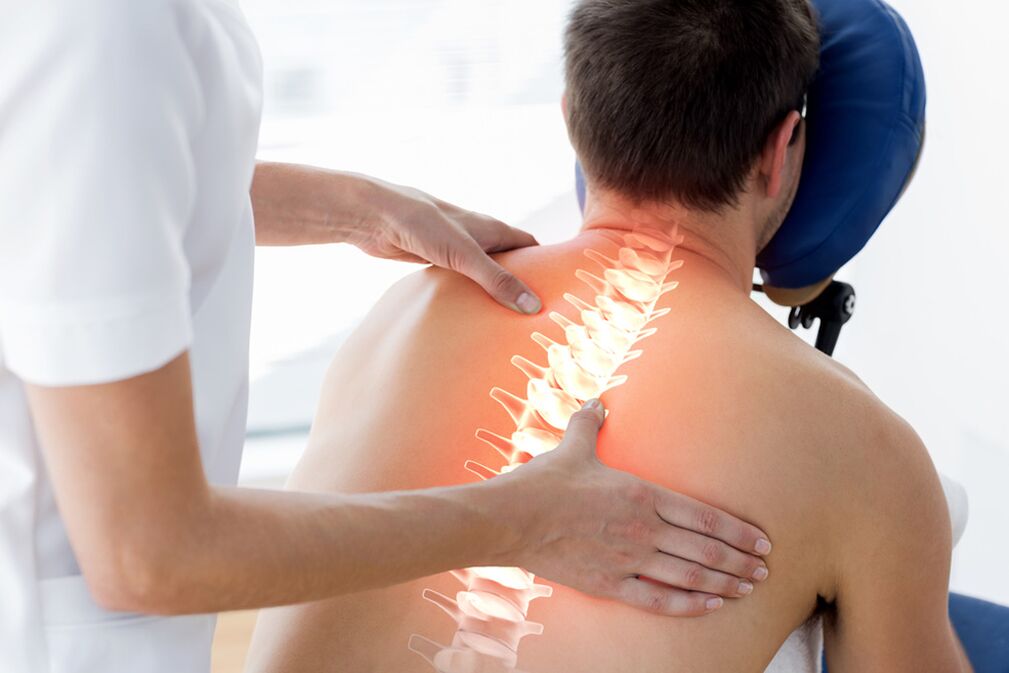Osteochondrosis of the thoracic spine occurs with damage to the intervertebral discs of the thoracic spine. The symptomatology of the disease is similar to the manifestations of cervical and lumbar pathologies. Thoracic osteochondrosis is difficult and is not often diagnosed.

Symptoms of thoracic osteochondrosis in women
This disease is rare in women, as there is less stress on the thoracic spine than on other parts of the spine. Thoracic osteochondrosis of the spine is quite difficult to diagnose, as the disease usually manifests itself in the stage of disease progression.
The main symptom of thoracic osteochondrosis in women is pain. The pain can usually be localized to the spine, sternum and also radiates to the upper limbs. In addition, a woman may suffer from stomach pain. The localization of pain depends, first of all, on the stage of the course of the disease.
Usually, with osteochondrosis of the thoracic spine, a woman feels constant, non-intense pain of a painful nature. Signs of thoracic osteochondrosis also depend on the sensitivity and individual characteristics of the female body.
In the beautiful half of humanity, the symptoms of the disease are more pronounced: a woman's body is more sensitive and all parts of the spine are thinner than those of a man. Degenerative and dystrophic processes in women are more likely to cause adverse reactions.
With the loss of the ridge chest section, the fair sex has the following symptoms:
- pain when raising the arm up or when bending;
- pain in the mammary glands;
- discomfort in the sternum, aggravated by various loads or prolonged standing in a sitting position;
- pain with deep breathing;
- severe pain between the shoulder blades in the crest area;
- feeling of pressure in the chest;
- vascular dystonia.
The above symptoms are provoked by processes occurring in the spine itself. In the case of the formation of intervertebral hernias, the symptoms appear as a consequence of the development of vascular and neurological pathologies.
Manifestations not less common in women with thoracic osteochondrosis:
- frequent occurrence of "groups" and numbness of the shoulders and arms;
- burning, cold or itching sensation in the lower extremities;
- pain in the heart area;
- increased brittleness of nails, skin peeling;
- pathologies of the functioning of the digestive organs: nausea, constipation or diarrhea, bloating.
Since osteochondrosis in the chest presents with symptoms similar to pneumonia, angina pectoris or cardiac pathologies, it is necessary to make a differential diagnosis. All of the above manifestations indicate the development of thoracic osteochondrosis. However, you should not self-medicate. Only a doctor can make an accurate diagnosis and prescribe an effective treatment.
Symptoms of osteochondrosis of the chest in men
Chest osteochondrosis in men is often diagnosed when there is a high intense load on the spine (for example, the disease is often detected in builders, loaders, etc. ). Clinical manifestations of osteochondrosis in this case occur gradually, while between the ribs and vertebrae there is a slow damage of the joints. The earlier the disease is diagnosed, the more effective the treatment will be.
In the early stages, thoracic osteochondrosis continues without any particular manifestation and the person lives without knowing that his disease is progressing. Any discomfort is usually attributed to fatigue that has arisen after a long workout, or an uncomfortable posture.
Signs of thoracic osteochondrosis in a man in the early stages:
- as a result of soft tissue compression, elasticity decreases in the joint area and a crack occurs between the shoulder blades, in the sternum region, the clavicle;
- due to impaired shoulder girdle flexibility, it is difficult to raise the arms and place them behind the back;
- discomfort appears in the affected part of the chest;
- after prolonged physical activity or standing in a static position, there is a feeling of fatigue in the back;
- the pain appears with deep breathing.
As the disease progresses, the following symptoms are noticed:
- the pain becomes more intense and persistent. Due to the constant pressure on the nerve endings, pain is also observed at rest;
- there is numbness, a tingling sensation in areas of impaired sensitivity;
- has periodic cramping reflexes of the abdominal muscles, continuing with discomfort;
- a man may suffer from false attacks of angina pectoris, renal or hepatic colic;
- possible disruption of the pelvic organs, as well as a decrease in strength;
- as a result of the formation of thoracic crest osteochondrosis, irritable bowel syndrome develops - a pathology of the functionality of the digestive organs.
Symptoms of coma in thoracic osteochondrosis
The feeling of a coma in the sternum appears in many patients, but not all pay attention to this, as this phenomenon is characterized by a short duration and disappears very quickly.
What causes this phenomenon? Usually, a coma in the sternum occurs as a result of pathologies of the nervous system. However, sometimes the cause of these sensations is chest osteochondrosis because in the chest area there are nerve plexuses in large quantities.
As a result of this pathology, intercostal neuralgia often develops. In this situation the patient has pressure behind the chest and pain also appears, which intensifies during body movements or while lifting weights. In this case, the pain is similar to needle piercing and intensifies during breathing.
Osteochondrosis of the chest region develops most often due to a wrong lifestyle, sedentary work and impaired metabolism. Conservative drug treatment, manual therapy and laser will come to the rescue. Patients are encouraged to go for sports or fitness.























